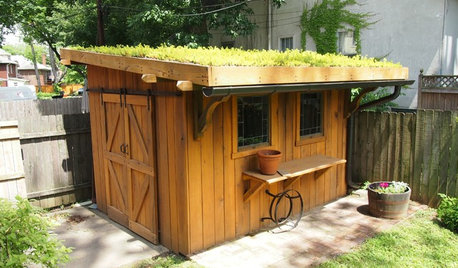Craftsman Lawn Tractor Problem
lafalot
15 years ago
Featured Answer
Sort by:Oldest
Comments (31)
mownie
15 years agolast modified: 9 years agoRelated Discussions
Craftsman Lawn Tractor Cranks but won't Start
Comments (10)I take it that the engine does not even TRY to start, but just spins when the starter is engaged. You need to make the test that mownie suggested. There are probably more safety interlocks than just the seat switch, and one of them could be "shorting" out the system. There is likely one on the clutch/brake pedal, and another on the PTO lever (the one that engages the blades), and one on the shift mechanism (to prevent starting if the transmission is in gear.) Testing these will require a multimeter. There is also a ground wire from the engine to the frame; typically on Husqvarna/AYP/Electrolux/Roper machines, it is a rather small black wire that is attached to the underside of the tractor frame just below the engine and inside the right front wheel. You've likely got a bad magneto or (more likely) either an electrical short caused by chafed insulation, corrosion, or loose connection, or a malfunctioning safety interlock switch. This all based on your being certain that there is no spark at the plug....See MoreCraftsman lawn tractor running problem
Comments (7)Check gas cap for a clogged breather hole in it. This could cause the problem you have stated! I got an old Wheel Horse tractor as a gift, when the owner said he was tired of the machine doing as you describe. I poked a larger hole in the cap, and the problem was solved! I offered the tractor back to him, but he said to keep it, which i did! Rusty J...See Morecraftsman lawn tractor problems
Comments (11)lawntrouble - picking up on tomplum's brake arm comment - there's only one "brake" on the machine called the park brake. It's located on the side of your auto transmission - consisting of a external disc and caliper with pucks. When you push your clutch/brake foot pedal fully down, first the ground drive belt is disengaged ad then the little disc brake is activated. Sometimes, that little disc brake can get corroded/trashed up to where the disc brake will not release by itself...and prevents the transmission from operating smoothly. Find the brake and then make sure it is not sticking. ENGINE OFF AND BE CAREFUL UP UNDER THERE. You may have to take off the mower deck and have an assistant operate the clutch/brake pedal while you are observing the little disc brake mechanism itself for correct movement. If dirty/corroded, apply brake cleaner that comes in the aerosol spray can to get it clean and working. If the brake linkage needs adjusting, refer to the procedure for such in your manual. (BTW, that manual that mownie chased down for you is indeed bilingual - BUT contains a complete english version. Get a copy if you do not have one now.) There can be several root causes to the type of prob you have (and possibly some others caused by those "repairmen" from sears)... some simple things to check: 1) make sure that the tranny freewheel control rod is fully pushed in (not hung partially out). It's located on the back frame lower left. 2) If either/both of the rear wheels have been taken off recently, make sure that both axle hub keys are correctly assembled. Hope all this might help. Post back with results/comments....See MoreCraftsman lawn tractor ignition problem
Comments (7)It would be helpful if you would post the actual engine Model number and Type number found on the engine itself. But yes, your next step should be to remove the spark plug and check for the presence of compression on the non working cylinder. It is simple enough and effective enough to just place a thumb over the spark plug hole and see if it has enough compression to force past your thumb and escape when you operate the starter. Be sure you move the spark plug cable far enough away that you don't inadvertently check for spark as well (shocking). If you find that the cylinder has no compression, your next step after that will be to remove the valve cover from that cylinder and look for a pushrod to have fallen out of place. I think that is enough for you to work with for now. Report back as soon as you know something....See Moremownie
15 years agolast modified: 9 years agolafalot
15 years agolast modified: 9 years agorustyj14
15 years agolast modified: 9 years agomachiem
15 years agolast modified: 9 years agobill_kapaun
15 years agolast modified: 9 years agolafalot
15 years agolast modified: 9 years agomownie
15 years agolast modified: 9 years agowalt2002
15 years agolast modified: 9 years agoMurrayGrowingMoss
15 years agolast modified: 9 years agomownie
15 years agolast modified: 9 years agoMurrayGrowingMoss
15 years agolast modified: 9 years agorcmoser
15 years agolast modified: 9 years agowalt2002
15 years agolast modified: 9 years agomownie
15 years agolast modified: 9 years agoMurrayGrowingMoss
15 years agolast modified: 9 years agoMurrayGrowingMoss
15 years agolast modified: 9 years agomownie
15 years agolast modified: 9 years agonjdpo
15 years agolast modified: 9 years agolafalot
15 years agolast modified: 9 years agodavidandkasie
15 years agolast modified: 9 years agojim98520
14 years agolast modified: 9 years agomownie
14 years agolast modified: 9 years agocand
14 years agolast modified: 9 years agoMichael Neavear
14 years agolast modified: 9 years agogunzlingr
13 years agolast modified: 9 years agonick88
13 years agolast modified: 9 years agomownie
13 years agolast modified: 9 years agofnash
8 years agorexlex
8 years agolast modified: 8 years ago
Related Stories

LANDSCAPE DESIGNProblem Solving With the Pros: Rustic Simplicity in a Country Garden
Editing thoughtfully and adding some magic result in a timeless weekend retreat
Full Story
REMODELING GUIDESThe Hidden Problems in Old Houses
Before snatching up an old home, get to know what you’re in for by understanding the potential horrors that lurk below the surface
Full Story
EARTH DAYThe Case for Losing the Traditional Lawn
Work less, help the environment and foster connections by just saying no to typical turf
Full Story
BEFORE AND AFTERSSee 6 Yards Transformed by Losing Their Lawns
Wondering whether a turf lawn is the best use of your outdoor space? These homeowners did, and they found creative alternatives
Full Story
LANDSCAPE DESIGN7 Low-Maintenance Lawn Alternatives
Turf isn't the only ground cover in town. Get a lush no-grass lawn with clover, moss and other easy-care plants
Full Story
GROUND COVERSGive Your Lawn a Taste of the Wild
Consider the joys of an irregularly trimmed meadow lawn: It’s ecofriendly, visually interesting and still good for romping
Full Story
REMODELING GUIDESHouzz Tour: Turning a ’50s Ranch Into a Craftsman Bungalow
With a new second story and remodeled rooms, this Maryland home has plenty of space for family and friends
Full Story
GARDENING GUIDESHow to Switch to an Organic Landscape Plan
Ditch the chemicals for a naturally beautiful lawn and garden, using living fertilizers and other nontoxic treatments
Full Story
DIY PROJECTSMake Your Own Barn-Style Door — in Any Size You Need
Low ceilings or odd-size doorways are no problem when you fashion a barn door from exterior siding and a closet track
Full Story
OUTBUILDINGSA Kentucky Garden Shed With a Planted Roof
Sedums help prevent runoff and add a green touch to this charming backyard building
Full StoryMore Discussions



lafalotOriginal Author